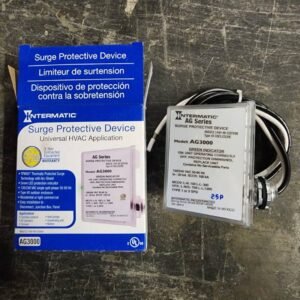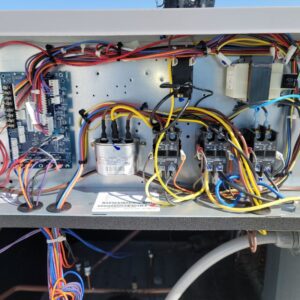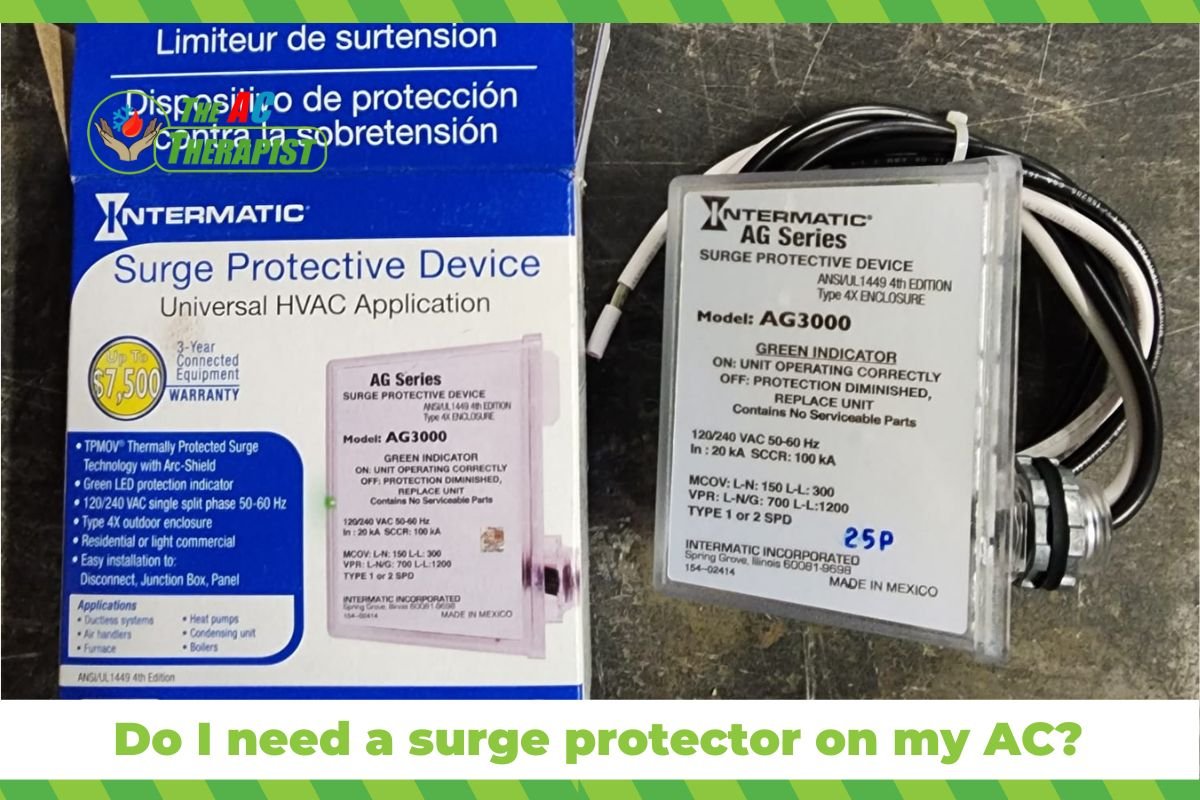Do I Need a Surge Protector on My AC? Understanding the Importance of Safeguarding Your Air Conditioner
Air conditioners have become an essential appliance in most households, especially during the hot summer months.
As the demand for energy-efficient and high-performance air conditioners has increased, so too has the need to protect these valuable investments from potential hazards.
One such hazard is a power surge, which can damage your air conditioning system and lead to costly repairs.
In this blog, we will delve into the importance of surge protectors for your air conditioner, how they work, and the factors to consider when choosing the right one for your needs.
What is a Power Surge and How Does It Affect Your Air Conditioner?
A power surge is a sudden and brief spike in voltage that occurs in the electrical system.
These surges can be caused by a variety of factors, including lightning strikes, faulty wiring, power grid fluctuations, and even large appliances turning on and off.
Although surges typically last only a fraction of a second, they can carry thousands of volts, which can damage or destroy sensitive electronic devices, such as your air conditioner.
Air conditioners consist of various electronic components, including compressors, capacitors, thermostats, and control boards.
A power surge can cause these components to fail or malfunction, leading to reduced efficiency, loss of cooling capacity, and, in extreme cases, complete system failure.
Installing a surge protector can help shield your air conditioner from the damaging effects of power surges and extend its lifespan.

How Do Surge Protectors Work?
Surge protectors work by safeguarding electronic devices from power surges, which are sudden and brief spikes in voltage that can damage or destroy sensitive electronics. These devices, also known as surge suppressors, are designed to regulate the voltage supplied to your electronic equipment, ensuring that it remains within safe levels.
The primary mechanism by which surge protectors function is by diverting excess voltage to the ground, limiting the voltage that reaches your electronic devices. When a power surge occurs, the surge protector detects the increase in voltage and instantly redirects the excess voltage to the ground wire, preventing the harmful voltage spike from reaching your devices.
Key components of a surge protector include:
- Metal Oxide Varistors (MOVs): MOVs are the primary components responsible for the surge protection function. These semiconducting devices react to increased voltage by changing their resistance. When the voltage is within the normal range, MOVs exhibit high resistance, allowing minimal current to flow through them. However, when a power surge occurs, the resistance of the MOVs decreases rapidly, allowing them to divert the excess voltage to the ground.
- Thermal Fuses: Surge protectors often include thermal fuses, which are designed to protect the device from overheating in case of extreme power surges. If the temperature within the surge protector rises above a safe level, the thermal fuse melts and disconnects the circuit, preventing potential fire hazards.
- Indicators and Status Lights: Many surge protectors feature indicator lights that provide visual confirmation of the device’s status. These lights can signal whether the surge protector is functioning correctly, if it’s grounded, and if it has absorbed its maximum capacity and needs to be replaced.
- Noise Filtering: Some surge protectors also include noise filtering capabilities, which help reduce electromagnetic and radio frequency interference. This can help improve the performance of your electronic devices by minimizing signal disruptions.
The effectiveness of a surge protector depends on several factors, including its Joule rating, response time, and clamping voltage. The Joule rating measures the energy-absorbing capacity of the surge protector, with higher ratings indicating greater protection. Response time refers to how quickly a surge protector can react to a power surge; a faster response time (typically one nanosecond or less) provides better protection. Clamping voltage is the voltage level at which the surge protector starts to divert excess voltage to the ground; lower clamping voltages generally offer better protection.
In summary, surge protectors work by detecting and diverting excess voltage during power surges, thus shielding your electronic devices from potential damage. They employ key components such as metal oxide varistors, thermal fuses, and indicator lights to ensure optimal protection and performance. Choosing a surge protector with a high Joule rating, fast response time, and low clamping voltage can help provide the best protection for your valuable electronics.

Types of Surge Protectors for Air Conditioners
There are two main types of surge protectors for air conditioners: whole-house surge protectors and dedicated air conditioner surge protectors.
- Whole-House Surge Protectors: These devices are installed at your home’s main electrical panel and protect all electrical devices in your home from power surges. Whole-house surge protectors are an excellent solution if you want comprehensive protection for all your appliances, including your air conditioner.
- Dedicated Air Conditioner Surge Protectors: These surge protectors are specifically designed for air conditioners and are installed directly at the AC unit. They provide a more targeted protection for your air conditioner, especially in cases where a whole-house surge protector may not be feasible.
Factors to Consider When Choosing a Surge Protector for Your Air Conditioner
- Joule Rating: The Joule rating of a surge protector indicates its capacity to absorb energy from power surges. The higher the Joule rating, the more protection the device offers. Look for a surge protector with a Joule rating of at least 600 for adequate protection for your air conditioner.
- UL 1449 Certification: Ensure that the surge protector you choose is certified by Underwriters Laboratories (UL) with the UL 1449 safety standard. This certification ensures that the device meets industry safety and performance standards.
- Warranty and Connected Equipment Coverage: A surge protector with a warranty and connected equipment coverage offers peace of mind, as it indicates that the manufacturer stands behind the product’s performance. Look for a surge protector with a generous warranty and a connected equipment coverage that matches or exceeds the value of your air conditioner. The Intermatic AG3000 has a 3-year connected equipment warranty of up to $7500.
- Type of Surge Protector: Consider whether a whole-house surge protector or a dedicated air conditioner surge protector is the best fit for your needs. If you want comprehensive protection for all your appliances, a whole-house surge protector may be the better choice. However, if you’re focused solely on safeguarding your air conditioner or if a whole-house surge protector isn’t feasible, a dedicated air conditioner surge protector would be more appropriate.
- Response Time: The response time of a surge protector refers to how quickly it can react to a power surge. A faster response time means better protection for your air conditioner. Look for a surge protector with a response time of one nanosecond or less.
- Indicator Lights: Surge protectors with indicator lights can provide visual confirmation that the device is functioning correctly and protecting your air conditioner. This can be particularly helpful in identifying when the surge protector has absorbed its maximum capacity and needs to be replaced.
- Professional Installation: Although some surge protectors can be installed by homeowners, it’s generally recommended to have a professional electrician handle the installation. This ensures that the surge protector is properly installed, grounded, and functioning optimally to protect your air conditioner.

What is the best surge protector for AC?
The Intermatic AG3000 surge protector is specifically designed for HVAC systems, central air conditioning units, and other large appliances. It is a good option if you are looking for a surge protector to protect your AC unit from voltage spikes and power surges. Some key features of the Intermatic AG3000 include:
- Designed for outdoor use: The AG3000 is built with a NEMA 3R-rated enclosure, making it suitable for outdoor installation and protection against the elements.
- Type 2 SPD (Surge Protective Device): The AG3000 is a Type 2 SPD, meaning it is designed to be installed at the service entrance or at the load side of the service entrance. It can help protect against both direct and indirect lightning strikes.
- Green LED indicator: The device features a green LED indicator that shows the proper functioning of the surge protector. If the LED is off, it indicates that the surge protection has been compromised, and the unit needs to be replaced.
- 120/240V single-phase protection: The AG3000 is designed to protect single-phase 120/240V electrical systems, making it suitable for most residential and light commercial applications.
- 3-year limited warranty: Intermatic offers a 3-year limited warranty for the AG3000 surge protector, providing some additional peace of mind.
While the Intermatic AG3000 is a good option for protecting an AC unit, it is not suitable for protecting general household electronics like computers, televisions, or home theater systems. For those devices, you should consider a different type of surge protector, like the APC SurgeArrest Performance or the Belkin 12-Outlet Pivot-Plug Power Strip Surge Protector mentioned in a previous response.
Where does the surge protector go on the AC unit?
A surge protector for an AC unit is typically installed near the outdoor condenser unit or the indoor air handler unit. The exact location may vary depending on the specific surge protector model and your AC system configuration. Here’s a general guide on where to install a surge protector on an AC unit:
- Outdoor condenser unit: For surge protectors designed for outdoor use, such as the Intermatic AG3000, you can install the device close to the outdoor condenser unit. You’ll need to connect the surge protector to the electrical disconnect box. Make sure to follow the manufacturer’s instructions and adhere to local electrical codes.
- Indoor air handler unit: Some surge protectors are designed to be installed inside your home, near the indoor air handler unit. This would be similar to the outdoor unit, install it at the electrical disconnect box. Again, follow the manufacturer’s instructions and local electrical codes.
- Electrical panel: In some cases, you may want to install a whole-house surge protector at your home’s main electrical panel. This type of surge protector can help protect your entire electrical system, including the AC unit, from voltage spikes and surges. Consult a licensed electrician for proper installation.
Keep in mind that surge protectors should only be installed by qualified professionals, as incorrect installation can lead to ineffective protection or even create a potential electrical hazard. Always consult a licensed electrician or HVAC technician for proper installation and ensure you follow the manufacturer’s guidelines and local electrical codes.

How to install a surge protector on your AC
Installing a surge protector on your AC unit should be done by a qualified professional, such as a licensed electrician or HVAC technician, to ensure safety and proper functioning. However, if you have experience working with electrical systems and are confident in your ability, you can follow these general steps to install a surge protector on your AC unit:
- Choose the right surge protector: Make sure you select a surge protector specifically designed for AC units, such as the Intermatic AG3000 or similar models.
- Turn off power: Before you begin the installation, turn off the power to the AC unit by switching off the circuit breaker in the main electrical panel. You should also turn off the disconnect switch near the outdoor condenser unit, if present.
- Find the electrical connection: Locate the electrical connection for the outdoor condenser unit. This can be an electrical disconnect box or a conduit connected directly to the unit.
- Mount the surge protector: Follow the manufacturer’s instructions for mounting the surge protector. This typically involves attaching the device to the disconnect box near the condenser unit or to the air handler unit indoors. Some surge protectors come with mounting brackets for easy installation.
- Connect the surge protector: Connect the surge protector’s wires to the appropriate terminals as specified in the manufacturer’s instructions. Generally, you will need to connect the following wires:
- Line (L) wire: Connect this wire to the load side (output) of the electrical disconnect or the AC unit’s power supply.
- Neutral (N) wire: Connect this wire to the neutral or grounded conductor in the electrical disconnect or the AC unit’s power supply.
- Ground (G) wire: Connect this wire to the grounding conductor in the electrical disconnect or the AC unit’s power supply.
- Double-check connections: Ensure that all connections are secure and properly tightened. Confirm that the surge protector is grounded correctly, as improper grounding can render the device ineffective.
- Restore power: Turn the power back on by switching on the circuit breaker in the main electrical panel and the disconnect switch near the outdoor condenser unit, if applicable.
- Test the surge protector: Check the surge protector’s LED indicator light or status display (if available) to ensure that it is functioning correctly.
Remember, working with electricity can be dangerous, and improper installation can lead to ineffective surge protection or electrical hazards. If you are unsure about any step in the process, consult a licensed electrician or HVAC technician for assistance.
How much does an AC surge protector cost?
The cost to install an AC surge protector can vary depending on several factors, such as your location, the complexity of the installation, and the HVAC technician’s labor rates. On average, you can expect to pay between $240 and $350 for professional installation of an AC surge protector.
Here are some factors that can influence the installation cost:
- Labor rates: HVAC technicians charge different rates depending on their experience, location, and the local market. In some areas, labor rates may be higher than in others.
- Surge protector cost: The cost of the surge protector itself can influence the overall installation cost. More expensive surge protectors may require additional installation steps or specialized knowledge. The Intermatic AG3000 cost about $70.
- Complexity of installation: If your AC unit or electrical system requires additional work to accommodate the surge protector, this can increase the installation cost. For example, if your electrical panel needs an upgrade or if your AC unit is difficult to access, the installation may take longer and cost more.
- Permits and inspections: In some locations, you may need to obtain a permit for installing a surge protector on your AC unit. The cost of the permit and any required inspections can add to the overall installation cost.
To get an accurate estimate for your specific situation, it’s best to contact a licensed electrician or HVAC technician in your area. They can assess your needs and provide a quote based on your AC unit and electrical system.
The Vital Role of Surge Protectors in Safeguarding Your Electronics
In conclusion, investing in a surge protector for your air conditioner is a wise decision to safeguard your valuable appliance from potential damage caused by power surges.
By understanding the different types of surge protectors available and considering factors such as Joule rating, UL 1449 certification, warranty, response time, and professional installation, you can choose the right surge protector to extend the life of your air conditioner and ensure its optimal performance.
To further enhance the safety and performance of your air conditioning system, consider enlisting the expertise of The AC Therapist.
As specialists in air conditioning maintenance, repair, and installation, The AC Therapist offers comprehensive services that can help you maximize the efficiency and lifespan of your AC system.
With their professional guidance and skilled technicians, The AC Therapist can help you select and install the ideal surge protector for your air conditioner, providing you with the peace of mind that your investment is well protected against unforeseen electrical hazards.
Trust AC Therapist to keep your air conditioning system running smoothly and efficiently, safeguarding your home’s comfort and your valuable appliances.









